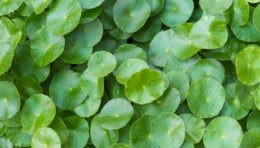Studies on gotu kola
Gotu kola shows an 80 % success rate in the prevention and treatment of cellulitis
Gotu kola has had sensational success in the prevention and treatment of cellulitis.
Studies show gotu kola has a 70 to 90 % success rate in treating phlebitis
In several studies, gotu kola has achieved a success rate of between 70 and 90 %. A study on 125 patients with phlebitis and brittle capillaries achieved a 90 % success rate using gotu kola, as published by the Gazette Medicale de France in 1971.
Gotu kola has positive effects on memory
Gotu kola has shown a positive effect on the memory in studies.
Gotu kola successful in studies against arthrosis
In vitro and in vivo cartilage degradation has been prevented by a standardised centella asiatica fraction.
Use of gotu kola
Gotu kola can be used both internally and externally. Corresponding products can be found in the form of:
- teas
- dried herbs
- tinctures
- capsules
- tablets and
- ointments
in dried form, the leaves are wonderful for infusing a healthy tea; fresh leaves can be incorporated into a salad.
Infusion of gotu kola herbal tea
To maintain the optimal antioxidant effect of the tea, it is recommended to boil the herbs for 10 minutes at 100 °C.
Dosage
Within the ayurvedic treatment, a maximum of two cups or 2-3 g powder mixed in fruit juices, or 2 x 30 drops of the extract, is taken per day.
Should you expect side effects when taking gotu kola?
Gotu kola is fundamentally safe. At higher doses, it may occasionally cause headache, stomach upset, nausea, dizziness, and increase pre-existing itching.
Overdose may cause extreme drowsiness or loss of consciousness.



